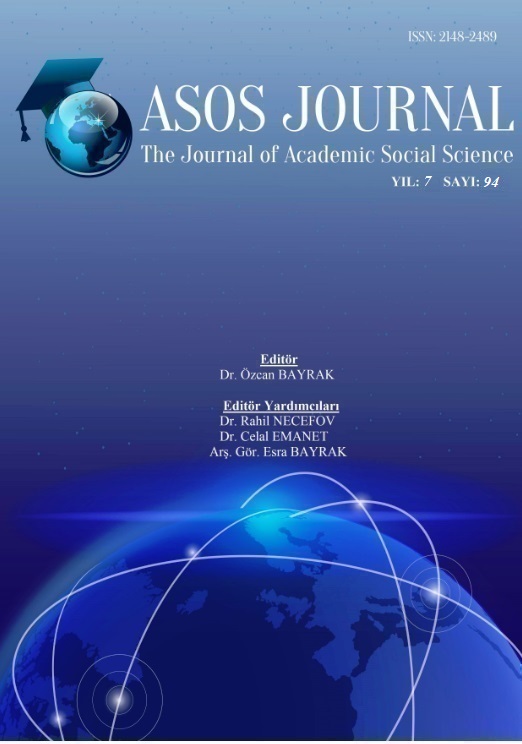SİNEMADA KLASİK KARA FİLMDEN (FİLM NOİR) YENİ KARA FİLME (NEO NOİR) GEÇİŞ: DÖNÜŞÜ OLMAYAN YOL (POİNT BLANK)
Author :
Abstract
Film Noir, 1940’larda ortaya çıkan, toplumsal yapıdaki ekonomik, kültürel ve politik sıkıntılar ve uyumsuzlukları perdeye aktarımıdır. Konu olarak belirsizlik içerisinde birtakım güçlerin birbirleriyle giriştiği mücadele, entrika ve cinayetin sıradanlaştığı karanlık bir dünya tasviridir. Bu türün filmlerinde diyalog akışındaki sertlik, görsel anlatı dilinde ağırlıklı olarak gece çekimleri, karanlık gölgeler, keskin ışıklandırma kontrastları, eğik kamera acılar hakimdir. Filmlerde karakterler kendi bildiğini okuyan, yalnız yaşayan ve genellikle şansızlıkların kaynağını oluşturan kadınlarla sınırlı ilişkiler kurabilen tipleri anlatılır. 'Film Noir'den 'Neo Noir'e dönüşümü ise zaman içerisinde gelişen, olgunlaşan ve ortaya çıkan bir durumdur. Bu ortaya çıkan durun hangi toplumsal dönüşümlerin sonucudur? Öne çıkan karakteristik özellikleri nelerdir? Bu özellikler Neo Noir'in gerek biçim gerekse de içeriğine yansıması nasıl olmuştur? gibi sorulara cevap arandığında, 1960’lı ve 1970’li yıllar Amerika’sı ile neden-sonuç ilişkileri bağlamında doğrudan bağlantılı olduğu görülmektedir. Toplumdaki ahlaki yapı, Amerikan başkanı J. F. Kennedy suikastı, siyahi lider Martin Luther King’in öldürülmesi, muhafazakârlaşmanın tırmanışı, öğrenci hareketleri, feminizm, cinsel devrim, anti-militarizm gibi benzeri sosyal gelişmeler, Neo Noir filmlerin yükselişinde etkili olmuştur. Bu çalışmada klasik kara filmi döneminden sonraki yeni kara film (neo noir) dönemi, anlatım yapısındaki geçirdiği değişimler ele alınmıştır. Bu amaçla sinema da klasik kara filmden (film noir) yeni kara filme (Neo Noir) geçiş bağlamında “Dönüşü Olmayan Yol” (Point Blank) filmi incelenmiştir. Film incelemesinde mekan, karakter ve ikonografik unsurlardaki değişimler irdelenmiştir. Anahtar Kelimeler: Sinema, Film Noir, Neo Noir, Anlatı, Dönüşü Olmayan Yol, Point Blank
Keywords
Abstract
Film Noir is the transfer of economic, cultural and political problems and inconsistencies in the social structure, which emerged in the 1940s. The subject is the depiction of a dark world in which the struggle, intrigue and murder become ordinary among some ambiguous forces. In the films of this genre, the intense dialogue flow, visual narrative language dominated by night shots, dark shadows, sharp lighting contrasts, and oblique camera angles are common. In the films, characters depict the types of people who have their own way, live alone, and often establish limited relationships with women who are the source of their misfortune. The transformation from 'Film Noir' to 'Neo Noir' is a phenomenon that develops, matures and emerges over time. What are the social transformations that led to this phenomenon? What are its characteristics? How did these features reflect Neo Noir on both form and content? As an answer to the aforementioned questions, it is seen that the relationship between the USA in the 1960s and 1970s is directly related to each other within the context of cause and effect relations. The moral structure of the society, the assassination of the President of the USA, J. F. Kennedy, the murder of the African-American leader Martin Luther King, the rise of conservatism, student movements, feminism, sexual revolution, anti-militarism and similar social developments were effective in the rise of Neo Noir films. This study discusses the neo noir period after the film noir period and the changes in the narrative structure of the neo noir. To this end, the movie Point Blank has been examined within the context of the transition from the film noir to the neo noir in cinema. The changes in space, character and iconographic elements are examined in the film analysis.
